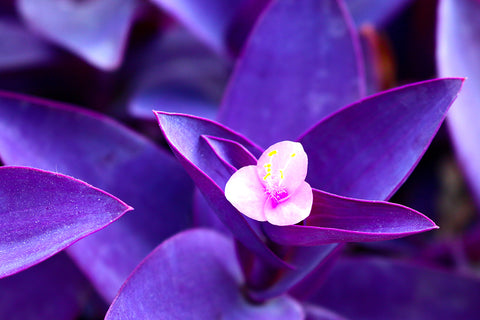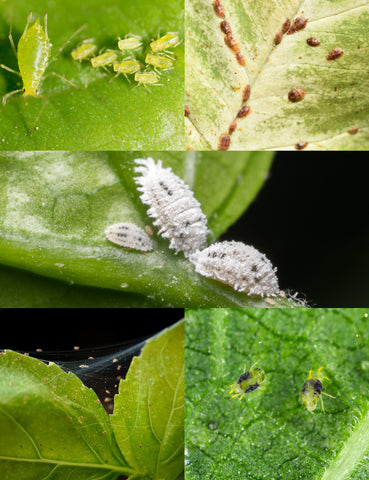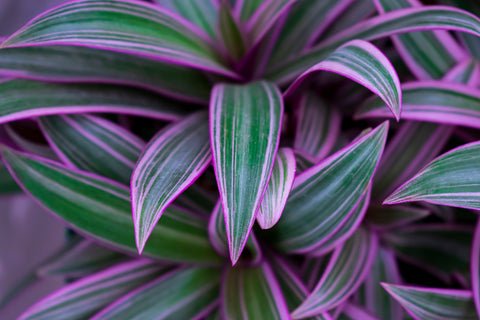TRADESCANTIA PLANT CARE GUIDE
HOW TO GROW AND CARE FOR TRADESCANTIA
By Julianne Blackaby | 09/08/2023

📷 Tradescantia 'Bubblegum', Chalet Boutique
|
Common Varieties |
Tradescantia zebrina (Wandering Jew), Tradescantia fluminensis (Inch Plant), Tradescantia pallida (Purple Heart), Tradescantia spathacea (Moses-in-the-Cradle), and Tradescantia albiflora (Spiderwort). |
|
Botanical Name |
Tradescantia spp. |
|
Family |
Commelinaceae |
|
Plant Type |
Perennial herbaceous plant |
|
Mature Size |
Varies by species; typically ranges from 15 to 60 centimetres in height. |
|
Light |
Bright, indirect light but can tolerate some direct sunlight. They are adaptable to different light conditions. |
|
Soil Type |
Well-draining aroid or premium potting mix |
|
Native Areas |
Americas, including North, Central, and South America. |
|
Toxicity |
Mildly toxic if ingested. It's recommended to keep them out of reach of pets and children. Skin contact with the sap may cause irritation in some individuals. |
Looking for a versatile and easy-to-care-for plant? Look no further than the Tradescantia! These plants come in a variety of colours and textures, making them a perfect addition to any indoor plant collection. Our comprehensive guide covers everything you need to know to keep your Tradescantia healthy and thriving, from watering and lighting to propagation and pest control. Whether you're a seasoned plant parent or just starting out, this guide has got you covered.
Tradescantias are evergreen perennial flowering plants native to North, Central and South America. Their common name is the Spiderwort plant or Wandering Jew plant. Tradescantias are a popular choice as an indoor plant because of their colourful foliage. Tradescantia varieties, such as the Fluminensis, have a trailing habit, can cascade down to a meter in length, and have delicate foliage. Others, such as the Pallida and the Spathacea, are dense clump-forming plants with succulent-type foliage. Most Tradescantia flower with three-petaled flowers in shades of pink, purple, white and blue in the summer, but they are generally grown for their foliage.

Our guide will provide all the information you need to keep your Tradescantia healthy and content, including tips on light and temperature needs, watering, fertilising, and how to propagate your plant. Let's embark on the journey of Tradescantia plant care together!
WELCOME TO YOUR COMPLETE GUIDE TO CARING FOR TRADESCANTIAS
HOW MUCH LIGHT DOES A TRADESCANTIA NEED?
Tradescantia can thrive in various light environments making them an ideal choice for many homes. In general, these plants prefer bright, indirect light but can also tolerate low light levels. To keep these plants thriving, place them in a spot where they will receive bright, indirect light for at least four to six hours daily. If you put your Tradescantia in direct sunlight, the leaves may scorch and turn brown. If the light is too low, the leaves may become smaller, lighter in colour and limp. To ensure your Tradescantia stays healthy, monitor its light levels and adjust accordingly. If you are unsure how much light your Tradescantia needs, try placing it in a bright, indirect light for a few weeks and observe how it responds.
HOW OFTEN SHOULD I WATER A TRADESCANTIA?
It is important to strike a balance when watering, as overwatering can cause root rot, while underwatering can cause the leaves to become pale and limp. Depending on your environment, Tradescantia can be watered once a week, allowing the soil to dry out slightly between waterings. In the summer, when temperatures are higher, and the plant is actively growing, it may need to be watered more frequently. If you are unsure if the soil is dry enough, stick your finger into the soil, and if the top 3-5 cm is dry to the touch, it is time to water. Additionally, when the plant is dormant in the winter, the soil should be allowed to dry out more before watering.
When you water your Tradescantias, you must provide enough water to the soil. If you can avoid the leaves from becoming too wet, water until it drains out of the pot's bottom. This will ensure the roots get the hydration they need to stay healthy. Alternatively, sit your plant in a water bowl for an hour or two and let it soak up the water from the drainage holes. This is called bottom watering. Remove from the bowl and let it completely stop dripping before you return it to its cover pot or saucer. If you suspect your plant has been overwatered, move it to a warmer spot and wait until the soil is dry before watering again.
WHAT IS THE BEST POTTING MEDIUM FOR TRADESCANTIA?
The best potting medium for Tradescantia is a good quality aroid mix containing orchid bark, peat moss, and perlite. A light and airy aroid mix that is well-aerated and moisture-retentive is ideal for Tradescantia. When the soil is mixed with water, it forms a perfect environment for root growth.

WHAT IS THE BEST TEMPERATURE FOR TRADESCANTIA?
Generally, the best temperature for Tradescantia is between 18-24 degrees Celsius. If the temperature rises above 24 degrees Celsius, the plants may become stressed and stop flowering. On the other hand, if the temperature drops below 18 degrees Celsius, the plants will become cold-stressed, and their growth may be stunted. To ensure the health and development of Tradescantia, maintain a constant temperature between 18-24 degrees Celsius. This can be achieved by keeping the plants in a bright, warm area away from strong drafts or cold air.
WHAT IS THE BEST HUMIDITY FOR TRADESCANTIA?
The best humidity for Tradescantia to thrive is 40-50% relative humidity which is average room humidity.
WHAT'S THE BEST FERTILISER FOR TRADESCANTIA?
We use Growth Technology, Foliage Focus for all our Tradescantias, here's why:
- Each GT Focus product is complete. Unlike the overwhelming majority of fertilisers, all Focus products contain each of the 12 essential minerals – including Calcium –blended into an easily absorbed liquid concentrate.
- pH buffered to ensure all 12 essential minerals are available to the plant.
- Formulated and balanced to suit the requirements of specific plant types.
- Manufactured using only the highest-grade raw materials and chelated trace elements to ensure effortless absorption by the plant.
- Guaranteed not to contain potentially harmful and ineffective chlorides, urea, sodium and ammonium.
- Easy to use with simple instructions.
- Makes up to 200 litres of working solution.

Top Left: Aphids, Top Right: Scale, Middle: Mealybugs, Bottom: Spidermites
WHAT ARE COMMON TRADESCANTIA PESTS, AND HOW DO YOU TREAT THEM?
Tradescantia can be susceptible to various pests, including aphids, mealybugs, spider mites, and scale insects. The use of beneficial insects such as ladybugs, lacewings, and parasitic wasps can be effective biological control against these pests.
Aphids are small, soft-bodied insects that feed on plant juices. They can be identified by their pear-shaped bodies, usually black, green, yellow, or brown. Aphids can weaken the plant by sucking out its sap, leading to yellowing and/or wilting leaves. Treatment for aphids includes spraying the plant with a strong water stream or using an insecticidal soap or neem oil solution.
Mealybugs are small, white, fuzzy insects that feed on plant sap. They are usually found in clusters on the underside of the leaves. Mealybugs can be treated with insecticidal soap or neem oil, or a cotton swab dipped in rubbing alcohol to wipe them off.
Scale insects are tiny, flat, oval-shaped pests that feed on plant sap. They can also be identified by the white, waxy coating they produce. Treatment for scale insects includes wiping them off with a cotton swab dipped in rubbing alcohol or spraying the plant with neem oil.
Spider mites are tiny, eight-legged arachnids that feed on plant sap. They cause yellowing and stippling of the leaves and webbing on the foliage. Treatment for spider mites includes spraying the plant with Kill-a-mite or Stealth.
By monitoring these common pests and treating them promptly, you can ensure that your plant stays healthy and continues to thrive.
HOW TO PROPAGATE A TRADESCANTIA
Tradescantias are easy-to-grow and fast-growing perennials, making them ideal for propagation. Propagating a Tradescantia is a relatively simple process that can be done in two different ways. The first method of propagation is through stem cuttings. To propagate a Tradescantia through stem cuttings, use clean, sharp scissors to cut a 10cm section of the stem just below a leaf node. Remove the bottom leaves and place the cutting in a clean glass of water. Make sure the leaves are not submerged in the water. Place the glass in a warm and sunny spot and change the water weekly. After a couple of weeks, the cutting should form roots, which can be planted in soil.
The second method of propagation is through division. This method is best done when the Tradescantia is in active growth. Carefully dig around the plant to separate the roots and any additional stems. Separate the sections with a knife or pruning shears, ensuring each section has a healthy root system and a few leaves. Plant the separated sections in a new pot filled with soil and water them well. Place the new pot in a warm and sunny spot and moisten the soil. With proper care, Tradescantia should establish new growth in no time.
With either method, adequate care and warmth are essential to successful propagation. Give the Tradescantia plenty of bright, indirect sunlight and water regularly but be careful not to overwater. With patience and care, you can propagate a Tradescantia in no time successfully.
WHEN DO YOU NEED TO REPOT A TRADESCANTIA?
You will know when it is time to repot your Tradescantia when the soil has become compacted, and the pot is too small for the root system. You will feel the pot is tight. When you water, the soil won't retain moisture, or the roots might come from the drainage holes. Repot if your plant shows signs of stress, such as wilting or discoloured leaves, is also essential. When repotting a Tradescantia, you should use a pot with plenty of drainage holes and fresh, well-draining soil. It is also important to water the plant thoroughly after repotting. Your Tradescantia can thrive in its new home with proper care and attention.

📷 Spathacea 'Stripe Me Pink'
WHAT SORT OF POT DO TRADESCANTIA Prefer?
Most Tradescantia are straightforward to care for and not very fussy. However, they prefer a shallow and wide pot instead of a deep and narrow one. This is because the roots of these plants are shallow. Using a pot with drainage holes at the bottom is best to ensure the potting medium remains moist but not soggy.
ARE TRADESCANTIAS TOXIC TO PETS AND CHILDREN?
Tradescantia can be toxic to pets and children when ingested. The sap of the plant contains several toxins, including saponins, which can cause gastrointestinal upset and vomiting if consumed. If a pet or child has eaten any part of a Tradescantia plant, they should be taken to a veterinarian or doctor as soon as possible.
